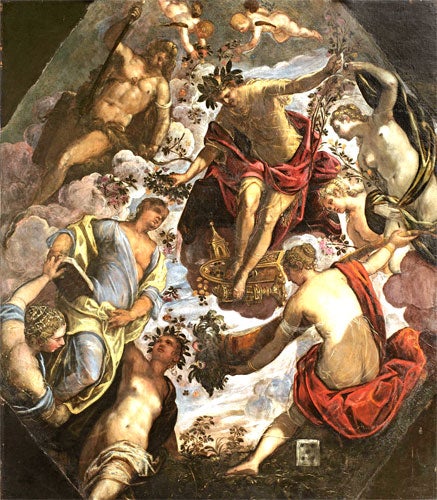Mystery solved as Italian masterpiece is unveiled
Restoration reveals priceless Tintoretto, reports Cahal Milmo

During his long career as one of Victorian England's most acquisitive gentleman explorers, William Bankes rightly gained a reputation for spotting a good bargain. Among the items he sent back from his travels abroad to his family seat in Dorset were an Egyptian obelisk, Venetian ceilings and Nubian carvings.
But until now a question mark has always hung over one of his most high-profile purchases – a painting of Apollo or possibly the god of marriage, Hymen, crowning a poet which Bankes attributed to the Italian Renaissance master Tintoretto but whose cracked and varnish-stained condition made expert attribution impossible.
That mystery was solved yesterday when, after a £36,000 cleaning and restoration project, the unusual octagonal masterpiece was put on public display for the first time in more than a century and revealed to indeed be the work of the Venetian artist whose dramatic use of light and vigorous energy while at work earned him the nickname "Il Furioso".
The National Trust unveiled the restored painting at Kingston Lacy, the ancestral seat of the Bankes family which was transformed by William in the first half of the 19th Century as he travelled Europe and the Middle East exploring his passions for Ancient Egypt, fine art and high-end souvenir shopping. The flamboyant aristocrat also achieved something of a reputation for enjoying himself: his friend and fellow dilettante Lord Byron described him as "the father of all mischief".
Kingston Lacy was renovated in a flamboyant Renaissance style by the architect Sir Charles Barry, designer of the Houses of Parliament and a friend of Bankes who set about achieving his client's instructions: "I found it brick and left it marble." The 450-year-old Tintoretto, which was entitled Apollo and the Muses when it was bought by Bankes in Italy in 1849, hung in the dining room until it was acquired by the Trust in 1981, by which stage the painting was in such poor condition that it had to be placed in storage until the funds could be raised for a full restoration. Work by experts at the Hamilton Kerr Institute, in Cambridge, to lift nearly 500 years of dirt, varnish and retouching has now revealed the picture in its full glory, confirming that it is one of the few Tintorettos to be held outside Italy.
Alastair Laing, the Trust's curator of pictures and sculpture, said: "This is undoubtedly a work of great significance – Titian, Veronese and Tintoretto are the three great masters of the mid-to-late 16th century Venice. To have a painting by Tintoretto in an English house, rather than still in its original location in Venice or in an Italian museum is extraordinary."
Despite settling the matter of the authorship of the painting, its restoration has had the unusual side effect of opening up a number of questions about its subject matter. The 8ft10 by 7ft9 canvas, which dates from the 1560s or 1570s, depicts a central figure, either Apollo or Hymen, crowning an androgynous figure while surrounded by several characters from mythology.
But the work seems to have been mistitled Apollo and the Muses because rather than featuring nine of the goddesses ruling the arts and sciences, it has just seven attending figures and a number of unexplained objects, including a single die with five dots and a gold cup, dish, box and steeple beneath Apollo's feet. The Trust is asking the public to offer explanations for Tintoretto's symbolism. Christine Sitwell, a painting conservation adviser, said: "The cleaning process has revealed the sheer quality and energy of Tintoretto and how he worked, but we are still baffled as to some of the content of the painting."
Quite what William Bankes thought of his acquisition once it was returned to England has gone unrecorded. The Cambridge-educated Egyptologist, whose meticulous drawings and descriptions form the only historical record of some inscriptions and monuments since lost to history, left Britain for Italy exile in 1841 after he was caught have a gay fling with a guardsman in a London park.
After what he referred to as his "strong weakness" became public, Bankes continued to send works of art back to Dorset with detailed instructions about how they were to be displayed. But he could never again publicly visit his stately home and is instead thought to have had to return secretly to England to admire his treasures.
Join our commenting forum
Join thought-provoking conversations, follow other Independent readers and see their replies
Comments